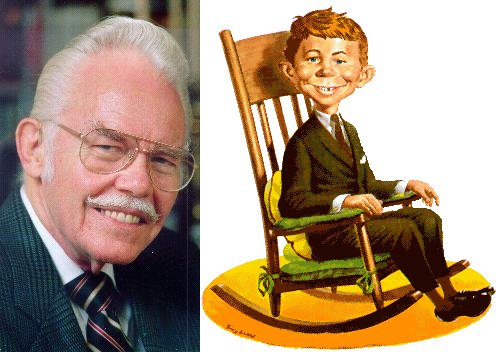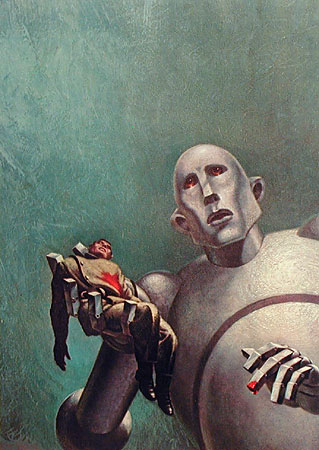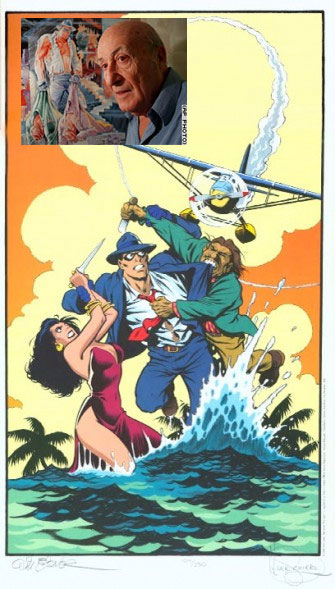| Author |
Message |
    
Soda
Citizen
Username: Soda
Post Number: 2274
Registered: 5-2001

| | Posted on Tuesday, January 4, 2005 - 12:49 pm: |     |
Frank Kelly Freas, Dead at 82.

"Frank Kelly Freas was universally recognized as one of the most prolific and popular science fiction and fantasy artists in the world. His distinguished career spanned fifty years from painting covers for Astounding Science Fiction and Planet Stories in the 1950's, to visualizing the most current concepts in science fiction illustration, gaming, and motion picture concepts, as evidenced by his winning the readers' poll award from Analog Magazine for Best Cover of the Year in 1991, two Chesley Awards [1990 and 1997] and the Writers of the Future Lifetime Achievement Award in 1999. In 2000 Freas was elected a Fellow of the International Association of Astronomical Artists.
Over the years, Freas' art has graced the covers of hundreds of science fiction books and magazines, including works by Poul Anderson, Isaac Asimov, Arthur C. Clarke, Robert Heinlein, Dean R. Koontz, Ursula K. LeGuin, Frederik Pohl, A.E. Van Vogt, etc. He also contributed covers to MAD Magazine from 1955 to 1962, as well as numerous other commercial illustrations, such as the record jacket for Queen's best-selling album, News of the world, and the cover of the 1992 Star Trek Annual for DC Comics. An official NASA artist, Freas' space posters hang in the Smithsonian Museum in Washington. He was also commissioned by the Skylab I astronauts to design their crew patch.
Dubbed the "most popular sf artist in the history of the field" by the respected Encyclopedia of Science Fiction, Freas is the first artist to have won ten Hugo Awards, the highest recognition granted to a science fiction artist, having been nominated an all-time record of twenty times. He has also won numerous other genre awards, including the NATTS's Hall of Fame in 1991. In 1994, Starlog Magazine included him in their prestigious list of The 200 Most Important People in Science Fiction and Fantasy.
Freas' original paintings hang in museums, universities, and private collections. His work has been the subject of three best-selling collections: The Astounding Fifties, Frank Kelly Freas: The Art of Science Fiction, and Frank Kelly Freas: A Separate Star. No other artist in science fiction has consistently matched his astounding record. His smooth and luminous images, amiable aliens and sexy women, have become part of today's science fiction landscape."
-s. |
    
Dave
Moderator
Username: Dave
Post Number: 4894
Registered: 4-1998

| | Posted on Tuesday, January 4, 2005 - 1:28 pm: |     |
 |
    
Arnomation
Citizen
Username: Arnomation
Post Number: 166
Registered: 7-2003

| | Posted on Thursday, January 6, 2005 - 1:17 am: |     |
No mention of Will Eisner's passing? For shame...
MIAMI, Florida (AP) -- Will Eisner, the artist who revolutionized comic books, helped pioneer the graphic novel and taught generations of soldiers how to maintain their equipment with the "Joe Dope" series, has died. He was 87.
Eisner died Monday at Florida Medical Center in Lauderdale Lakes of complications from quadruple bypass heart surgery last month, according to Denis Kitchen, Eisner's agent and publisher for three decades.
"He was absolutely the greatest innovator the industry ever saw," Kitchen said.
Eisner started making comics in the 1930s and was the first to use "silent" balloonless panels to emphasize characters' emotions by focusing attention on finely wrought facial expressions.
He addressed subjects considered unthinkable in comic books and rarely seen at the time in newspaper comics: spousal abuse, tax audits, urban blight and graft.
"He set not only a high standard of work, he has opened the door that very few people have gone through, which is to recognize comics as a legitimate storytelling medium," said Max Allan Collins, whose graphic novel "Road to Perdition" was turned into a movie starring Tom Hanks.
The graphic novel combines elements of comic books and literary novels. His first, "A Contract with God," was published in 1978 and had stories of his childhood and the immigrant Jewish experience in a poor Brooklyn tenement.
"He had a real capacity to bring hope to the most dire circumstances ... the toils of immigrant life," said Robert Weil, an executive editor at W.W. Norton, which is publishing two Eisner books this year.
In 1940, he created a gritty weekly newspaper supplement titled "The Spirit," which at its height had a circulation of 5 million in 20 Sunday newspapers. The supplement consisted of a comic book with three self-contained stories, and "The Spirit" became the most popular.
Its title character was a detective named Denny Colt, believed murdered by a mad scientist's potion but actually buried alive. He protected the fictional Central City, which was based on New York.
But the series' lead character usually took a back seat to others. "The stories would focus not necessarily on 'The Spirit,' but on some poor average Joe who was having a bad day," Collins said.
Eisner "had been producing comic books for 15-year-old cretins from Kansas," he told The Associated Press in a 1998 interview. With "The Spirit," he was aiming for "a 55-year-old who had his wallet stolen on the subway. You can't talk about heartbreak to a kid."
Michael Chabon, author of "Wonder Boys," said he interviewed Eisner before writing "The Amazing Adventures of Kavalier and Clay," a book about two cousins who created a comic book superhero and his battles against Hitler.
"He was unquestionably the first person who ever took comic books seriously as an art form," Chabon said. He said Eisner spoke publicly about the artistic value of comic books as early as 1940.
"Even the guys who were making the comic books and those were the most talented thought what they were doing was worthless garbage," Chabon said.
Eisner was drafted during World War II, and the Army had him create "Joe Dope" to teach Jeep maintenance to soldiers with a bumbling comic-strip character.
After the war, he went back to "The Spirit" and continued the series until 1952. The Army also hired him for more instruction manuals, which he produced until the 1970s, Kitchen said.
"Will was a multi-faceted treasure," said Paul Levitz, president and publisher of DC Comics, which has released reprints of "The Spirit." Eisner was "a pioneer as a cartoonist as well as a young entrepreneur at the dawn of comic books.

http://www.willeisner.com/ |
    
Duncan
Supporter
Username: Duncanrogers
Post Number: 3747
Registered: 12-2001

| | Posted on Thursday, January 6, 2005 - 10:15 am: |     |
Arnomation.. heard a piece about his passing on NPR the other day. He sounded like quite the vanguard in his field.
Looking forward to your presentation at the next PIM meeting greatly. I just worked with someone you may know. Does the name Deb Hurwitz ring any bells?
cheers |
    
Arnomation
Citizen
Username: Arnomation
Post Number: 167
Registered: 7-2003

| | Posted on Thursday, January 6, 2005 - 10:36 am: |     |
I was actually fortunate to have him as an instructor when I was at the School of Visual Arts. He was a great guy.
That name (Deb Hurwitz) doesn't ring a bell. What does she do?
I'm actually going down to check out the 'Here's To The Arts space later today to make sure there's enough room for the dancing girls and the juggler.....maybe I'm thinking of a different presentation..
Mike |
|